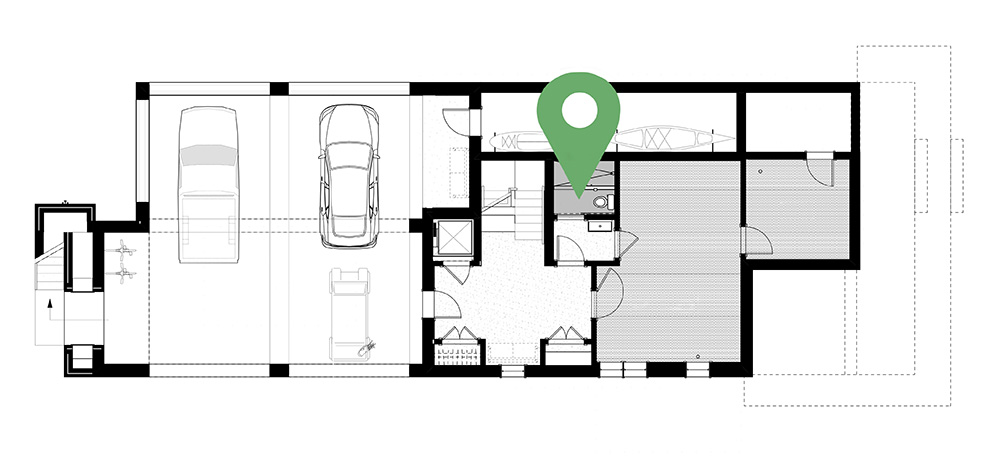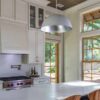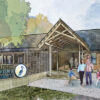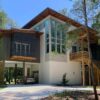Studio Bath

Sustainable Design Strategies
Planning and Design
![]() One of the mantras of sustainable design is “long life, loose fit.” Highly specialized spaces for specific functions can become obsolete over time, making it more difficult and resource intensive for the building to be used for 50 or 100 years. The Studio Bath is designed to serve as a powder room serving the ground floor entry, covered, parking, and the backyard, and also as a full bath for the Studio Flex space so that it can be used as a short or long term guest room. The bath is lockable from both sides, but even so, it’s not always comfortable using a bathroom accessed by two doors. For that reason, the lavatory space is separated from the wet room as an additional privacy measure.
One of the mantras of sustainable design is “long life, loose fit.” Highly specialized spaces for specific functions can become obsolete over time, making it more difficult and resource intensive for the building to be used for 50 or 100 years. The Studio Bath is designed to serve as a powder room serving the ground floor entry, covered, parking, and the backyard, and also as a full bath for the Studio Flex space so that it can be used as a short or long term guest room. The bath is lockable from both sides, but even so, it’s not always comfortable using a bathroom accessed by two doors. For that reason, the lavatory space is separated from the wet room as an additional privacy measure.
Lighted Mirror
![]() The Martell lighted mirror by Kichler is a simple uncluttered element which eliminates the need for additional vanity lighting in a compact space. The efficient LED fixtures save energy.
The Martell lighted mirror by Kichler is a simple uncluttered element which eliminates the need for additional vanity lighting in a compact space. The efficient LED fixtures save energy.
WaterSense Faucet and Sink
![]() The WaterSense certified, Trinsic faucet by Delta has a clean modern design, and is meant to reinforce the indoor outdoor connection with visual similarities to a simple spigot or hose bib. WaterSense certified faucets conserve both water and energy, by reducing hot water use, and increasing savings on utility bills. The average family could save 700 gallons of water a year by switching to Water Sense certified faucets.
The WaterSense certified, Trinsic faucet by Delta has a clean modern design, and is meant to reinforce the indoor outdoor connection with visual similarities to a simple spigot or hose bib. WaterSense certified faucets conserve both water and energy, by reducing hot water use, and increasing savings on utility bills. The average family could save 700 gallons of water a year by switching to Water Sense certified faucets.
Dual Flush Toilet
![]() WaterSense certified, Kohler Veil toilets not only conserve water, but minimize the use of potable water to convey sewage, while saving the homeowner on both water and sewer costs. The Inspiration Home dual flush toilets can be flushed with either .8 or 1.28 gallons of water, allowing water to be used only as needed for a successful flush.
WaterSense certified, Kohler Veil toilets not only conserve water, but minimize the use of potable water to convey sewage, while saving the homeowner on both water and sewer costs. The Inspiration Home dual flush toilets can be flushed with either .8 or 1.28 gallons of water, allowing water to be used only as needed for a successful flush.
You might not know that toilets are by far the biggest source of water use in most homes, and in many cases a significant source of water waste. The average family could save about 13,000 gallons a year by switching to water sense toilets and $2,900 over the lifetime of the toilets. This also saves the energy required for sewage treatment, and the pollution associated with generating that energy, at a community level. Nationally, if all old, inefficient toilets in the United States were replaced with WaterSense labeled models, we could save 520 billion gallons of water per year, or the amount of water that flows over Niagara Falls in about 12 days.
Even if your toilet is relatively new, it could be wasting water through a silent leak. You can find out if your toilet is leaking by putting a drop of food coloring in the tank. If after 10 minutes or so, you see colored water in the bowl, then your flapper needs to be replaced.
Contemporary Toilet Paper Holders with Grab Bars
![]() These clever contemporary toilet paper holders from the Delta Decor Assist line are designed with a subtle, integrated grab bar. This feature eases use for people of all ages and abilities, and adds to the adaptability of the space.
These clever contemporary toilet paper holders from the Delta Decor Assist line are designed with a subtle, integrated grab bar. This feature eases use for people of all ages and abilities, and adds to the adaptability of the space.
Curbless Shower
![]() The shower is designed without a curb, for ease of use and accessibility. Behind the wall tile, blocking has been provided for grab bars. These add stability and security for all users and allow the shower to be used by people with a range of ages and abilities.
The shower is designed without a curb, for ease of use and accessibility. Behind the wall tile, blocking has been provided for grab bars. These add stability and security for all users and allow the shower to be used by people with a range of ages and abilities.
The Delta Trinsic slide bar shower head and hand shower make the shower adaptable for use by small children or even someone who is injured or disabled. The hand shower is convenient for cleaning every corner. The fixtures have simple modern lines which set off the wood grain in the wall tile and natural wood in the bath, and are intended to bring a bit of zen to the bath
WaterSense certified showers conserve both water and energy, by reducing hot water use, and increasing savings on utility bills. The average family could save 2,700 gallons a year by switching to Watersense certified showers. The energy that could be saved each year by an average family switching to Watersense certified showers is enough to power a home for 11 days.
Wall and Floor Tile
![]() Crossville’s Nest tile with subtle wood graining is used on the walls and shower floor, while their Notorious line, which references the patina of concrete, is used on the floor. The natural textures and forms reinforce the biophilic interior environment.
Crossville’s Nest tile with subtle wood graining is used on the walls and shower floor, while their Notorious line, which references the patina of concrete, is used on the floor. The natural textures and forms reinforce the biophilic interior environment.
Crossville tile and porcelain slabs are made in Crossville TN, less than 500 miles from Fairhope, and between 95%-95% of the materials used in these products are sourced from within 500 miles of the factory. Using local and regional materials reduces the carbon impact and emissions associated with transporting raw and finished materials over long distances.
Crossville is a leader in sustainable manufacturing processes. They reuse more than 99.98 percent of water used in manufacturing. The small amount that is not reused is returned clean to the environment. Through a certified recycling processes, they recycle approximately 12 million pounds of material that previously went to landfills. Crossville remains the only tile manufacturer with a Tile Take-BackTM Program, allowing previously installed tile from any manufacturer to be returned to Crossville for recycling. Crossville works with TOTO USA, the world’s largest plumbing products manufacturer, to recycle pre-consumer waste. Crossville has developed a proprietary system of processing TOTO’s sanitary ware waste back into powder used in manufacturing new tile.
In March 2011, Crossville became a net consumer of waste, meaning they recycle more waste into new products. This recycling conserves resources; the volume of finished goods Crossville ships now exceeds the amount of raw materials it extracts from the earth for use in manufacturing.
Crossville tile and porcelain slabs are clean materials. The ingredients used in the tile and porcelain slabs are fully disclosed down to one part per million, and are disclosed through the Declare (link) Health Product Declaration to contain no red list (link) ingredients. Crossville also provides an Environmental Product Declaration quantifying the life cycle impacts of its products.
UltraLight Gypsum Drywall
![]() US Gypsum USG Sheetrock® Brand UltraLight Panels are Greenguard Gold certified, low emitting materials. Sheetrock is ubiquitous in construction, it is a heavy material used in large quantities. Using light weight drywall is a simple step that greatly reduces the pollution associated with transporting the materials from manufacture to the site.
US Gypsum USG Sheetrock® Brand UltraLight Panels are Greenguard Gold certified, low emitting materials. Sheetrock is ubiquitous in construction, it is a heavy material used in large quantities. Using light weight drywall is a simple step that greatly reduces the pollution associated with transporting the materials from manufacture to the site.
USG Sheetrock® Brand UltraLight Panels are 1/2 in. (12.7 mm) gypsum panels that feature proprietary core and paper technologies, resulting in a high strength-to-weight ratio composite design. These lightweight panels are also engineered to have superior sag resistance, eliminating the need for traditional 1/2 in. (12.7 mm) sag-resistant ceiling panels. The noncombustible gypsum core is encased in 100% recycled face and back papers, The light weight design is easier for installers to work with, and can improve construction speed and safety.
People tend to think of the environmental impact of a home or building in terms of energy use and utility bills. However, building materials also create significant environmental impacts, through the pollution associated with their extraction, manufacture, and transportation to the job site. This is called “embodied carbon,” with carbon being an indicator of all greenhouse gases, not just carbon dioxide. The environmental impacts of building materials are also front loaded in time, while a building’s energy use creates incremental impacts over a lifetime of use. Since the emissions that we produce between now and 2050 will determine whether or not we avoid the worst impacts of climate change, the embodied carbon of building materials matters a great deal.
For the greatest impact, prioritize the selection of locally produced and sustainably manufactured materials for heavy items that are needed in large quantities, like brick, concrete, framing, or drywall.
Wood Doors and Trim
![]() Solid wood doors and finger jointed molding use wood sourced from Koetter’s own managed forests that were planted from vacant land. Keotter has won multiple awards for forest management Including the “Good Steward” award from the Arbor Day foundation and the Forestry Award from the Indiana Wildlife Federation. Solid wood doors are naturally low emitting materials. Finger jointed molding conserves materials by utilizing smaller pieces of wood joined together.
Solid wood doors and finger jointed molding use wood sourced from Koetter’s own managed forests that were planted from vacant land. Keotter has won multiple awards for forest management Including the “Good Steward” award from the Arbor Day foundation and the Forestry Award from the Indiana Wildlife Federation. Solid wood doors are naturally low emitting materials. Finger jointed molding conserves materials by utilizing smaller pieces of wood joined together.
The curved shapes of moldings and door panels balance the strong lines of the cabinets and reinforce the biophilic interior design, by echoing organic forms, like the curve of a wave or a seashell.
Interior Paint
![]() The interior paint is Greenguard Gold certified as a low emitting material, or has an equivalent certification with small chamber testing. This means that the paint has been tested in a sealed chamber where any off gassing can be analyzed and measured for compliance with health standards. This is not the same as being labeled “low emitting”. Many products are labeled “low emitting” that simply meet legal requirements for the volatile organic compounds in their ingredients. They may only be “low” compared to materials that are no longer legal to use, hardly something to brag about.
The interior paint is Greenguard Gold certified as a low emitting material, or has an equivalent certification with small chamber testing. This means that the paint has been tested in a sealed chamber where any off gassing can be analyzed and measured for compliance with health standards. This is not the same as being labeled “low emitting”. Many products are labeled “low emitting” that simply meet legal requirements for the volatile organic compounds in their ingredients. They may only be “low” compared to materials that are no longer legal to use, hardly something to brag about.
Indoor Air Plus certification requires that 90% of all paints, stains, and coatings applied inside the home meet GreenGuard Gold or an equivalent certification. Not only the paint, but also all of the stains, coatings, adhesives, sealants, and caulks in this home were carefully screened to prevent emissions that could contaminate the interior of this home.
All of the paint colors used in the Inspiration Home contain no black or grey pigment, which make them extremely dynamic and responsive to differing conditions of daylight. This mimics the dynamic appearance of colors found in nature and is one of our biophilic design strategies.










